This Fermented Sprouted Porridge Bread is a unique bread made from grains that have been sprouted, then fermented, and cooked into a porridge. If you like a slightly sweet and toothsome wheaty texture, you’ll love this loaf! I used sprouted einkorn grains and spelt flour, but you could make this bread with any wheat grains you choose.
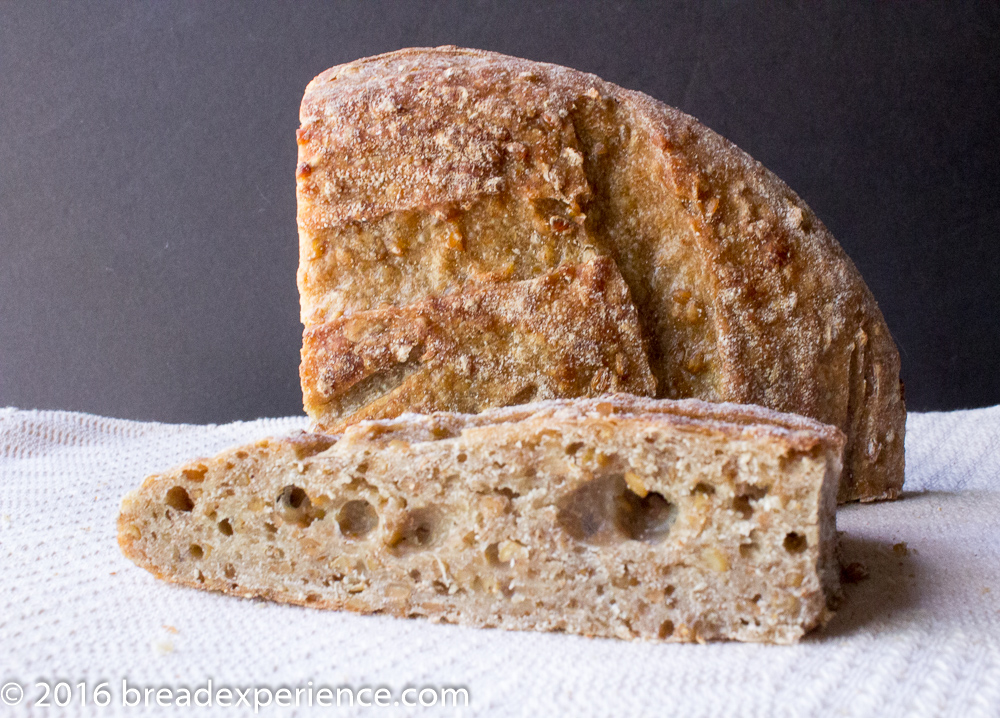
This bread takes several days to make, but it is worth it. Most of the time is spent either sprouting or fermenting the dough.
However, when I made it, it took a few weeks because after I sprouted the grains, I couldn’t decide what I wanted to make with them. Rather than letting the sprouts go to waste, I dried them and was planning on milling them into flour. I put the dried grains in a jar for safe keeping and about that time, I ran across an interesting post in one of the Facebook baking groups I follow. The baker posted a photo of some fermented sprouted grains.
I thought that was a great idea so I started looking through my bread books and found a fermented bread in Chad Robertson’s book, Tartine 3 which led me to Sandor Katz’s book, Wild Fermentation, and then back to Tartine 3. I had fun researching and learning how to make the porridge bread; however, what I didn’t know was if it would work well with sprouted grains that had been dried.

I set out to find out if the dried grains would work for fermenting, and in the porridge. I was delighted with the way my experiment turned out. This may not be a fabulous-looking bread, but the flavor is extraordinary.
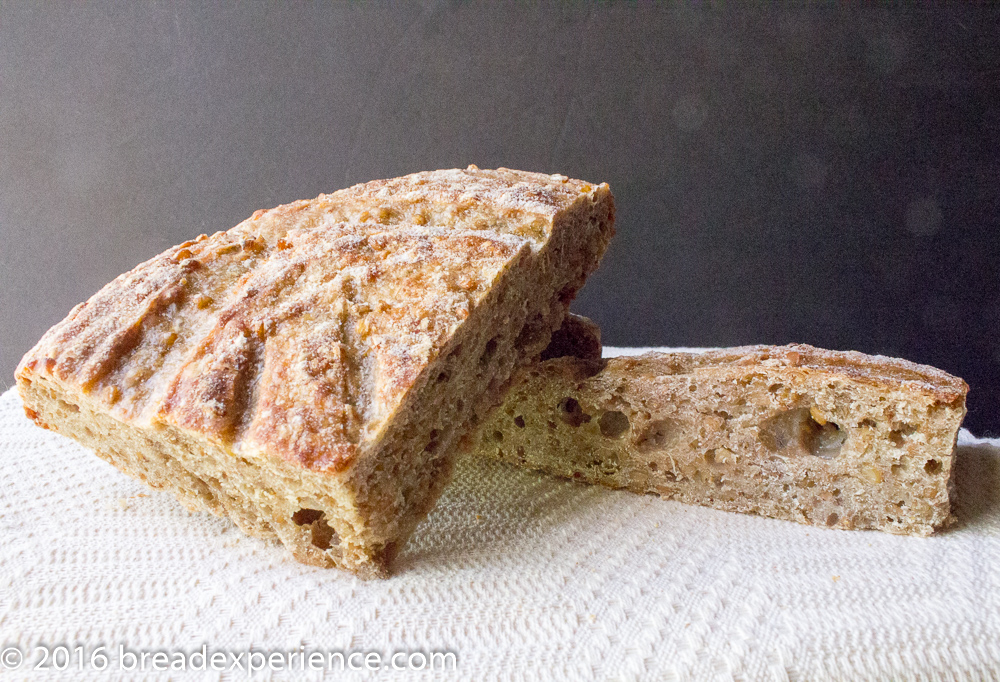
Here is the method I used to make this Fermented Sprouted Porridge Bread:
Day 1: Sprout the grains
The first phase is sprout the grains. This is the method outlined in Peter Reinhart’s Bread Revolution.
In the morning, take 250 grams wheat berries and using fresh, cool water, rinse and drain them a couple of times to remove any resin. Place them in a bowl and cover with water by 1 inch.
Let the grains soak for 3-5 hours. Drain out the water, then rinse and drain again and let them sit, covered until that evening.
Later that evening, before bed, rinse the grains again and let them drain overnight in a jar fitted with a screened lid or in a strainer.
The next morning or later, depending on the temperature in your kitchen, you will see tiny shoots (or nubs) appear. Once the nubs split into two thin shoots, they will be ready for the next step.
Day 2 (afternoon or evening): Ferment the grains
Place 500 grams of water in a jar. Stir in 1 tsp of sourdough starter and mix until dissolved.
Add the 250 grams of sprouted wheat from the previous step. Cover the jar and let the sprouts ferment for 24 hours.
Day 3: Prepare the Porridge
Pour the fermented grains and water into a medium saucepan and cook until it becomes a thick and creamy porridge. Season it with salt. Spread the porridge on a baking sheet to cool. I used a baking sheet lined with foil. Once the porridge is cooled, transfer it to a container, cover and place it into the refrigerator until ready to use in bread. The porridge will last about a week in the refrigerator. Just be sure to bring it back to room temperature before using it in bread.
Day 4 (or up to a week later): Make the Bread
I made the bread about two days after making the porridge.
Remove the porridge from the refrigerator and let it warm up to room temperature before using it in this bread.
Levain:
- 1 tablespoon spelt sourdough starter (or whatever sourdough starter you have)
- 100 grams all-purpose spelt
- 100 grams whole grain spelt
- 200 grams water
In a medium bowl, dissolve the starter in the water. Add the flours and mix thoroughly. Cover and let the levain rest overnight, 8 – 12 hours, depending on the temperature in your kitchen. Do the float test to see if it is ready by taking a pinch of the levain and dropping it into a small clean bowl of water. If the levain floats, it is ready to use in the bread. If it doesn’t float, let it rest for another hour at room temperature and perform the float test again.
Final Dough:
- 150 grams spelt levain
- 550 grams water
- 600 grams all-purpose spelt
- 200 grams whole grain spelt
- 25 grams fine sea salt plus an additional 10-15 grams water
- 500 grams porridge
Once the levain has passed the float test, place it in a large bowl and pour the water over it. Stir completely to break up the levain. Add in the flours and mix thoroughly until it becomes a shaggy mass. Mix in the cooled porridge using a Danish dough whisk, a dough scraper, or your fingers. Let the mixture rest for 30 minutes, then add the salt and 10-15 grams of water to dissolve the salt. Mix with your fingers until the salt is thoroughly incorporated throughout the dough.
Cover the dough and let it bulk ferment for 3 hours. After the first hour, fold the dough. Spraying the counter with water will help keep the dough from sticking without having to add additional flour. Place the dough back in the bowl, cover and let it continue to bulk ferment for 2 more hours. Fold the dough again after 1 hour. Then let it rest for the final hour.
Divide the dough into two equal pieces. Shape them into rough rounds and let them rest on the counter for 15 minutes. Shape them into tighter rounds and place them seam-side up in proofing baskets. Place the proofing baskets in the refrigerator to retard overnight.
Day 5: Bake the Loaves
The next day, place a cloche on the bottom rack of the oven and preheat the oven to 450 degrees F. for about an hour.
When the oven and the baker are preheated, remove the baker to a thick pad or kitchen towel to protect it from the temperature change. Sprinkle the bottom of the cloche with cornmeal.
Remove one proofing basket from the refrigerator and carefully flip the loaf onto the cornmeal-dusted base of the cloche. Score the loaf in the pattern of your choice and place the cloche back into the preheated oven. Bake with the lid on for 20 minutes. Remove the lid and bake for an additional 20-25 minutes.
Remove the loaf and cloche from the oven and place the loaf on a wire rack to cool completely.
Return the cloche to the oven and let it warm back up to 450 degrees. Repeat the baking process with the other loaf.
Let the loaves cool completely before slicing. You may even want to wait until the next day to slice it.
This bread keeps well due to the sourdough and the sprouted grains, but you will want to place it in the refrigerator after a day or so to keep it from getting moldy.
- Sprouted Einkorn
- Dried sprouted grains
- Fermenting sprouted grains
- Cook, then cool the porridge
- Levain
- Mixing porridge into dough
- Bulk ferment
- Dough in proofing basket
- Scored loaf ready to bake
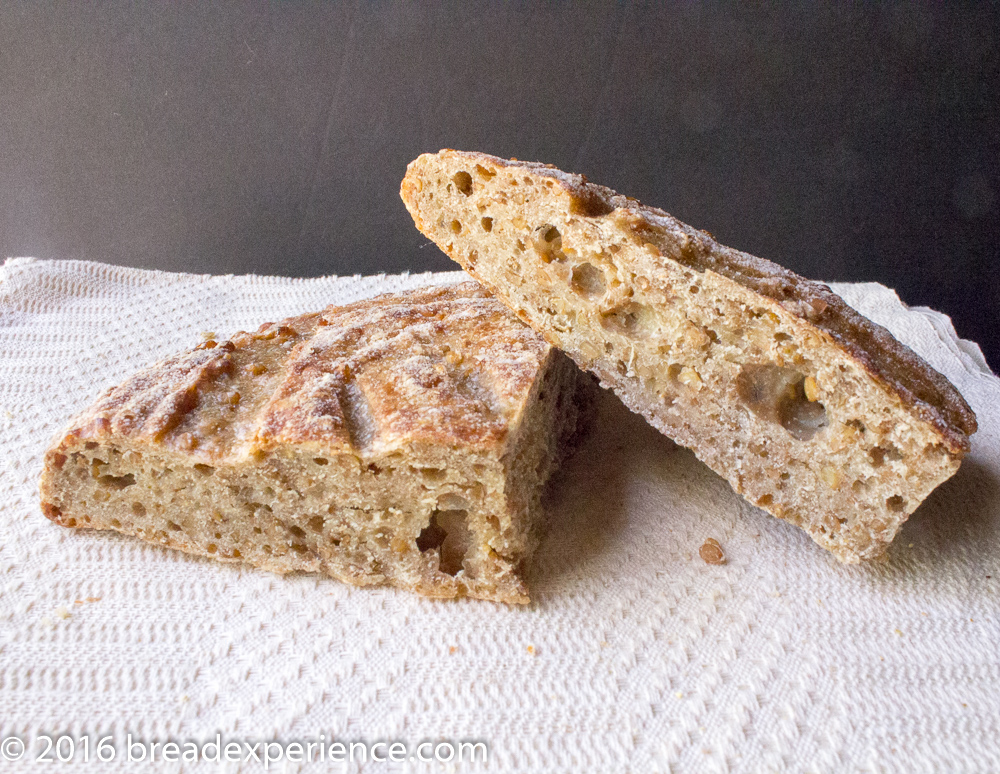
This bread is very satisfying in a comforting way due to the nutritional and digestive properties of the bread. I enjoyed it! I hope you do too!
Happy Baking!
Cathy
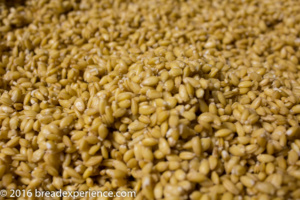
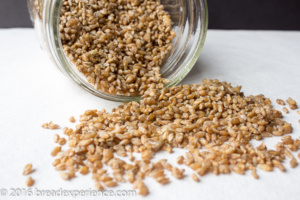
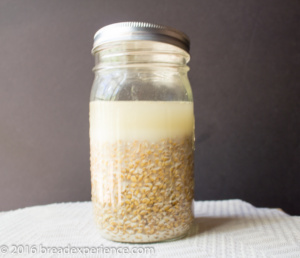
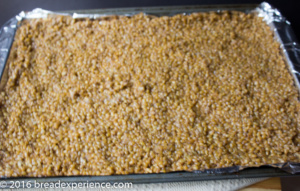
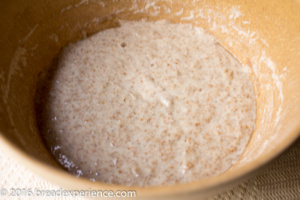
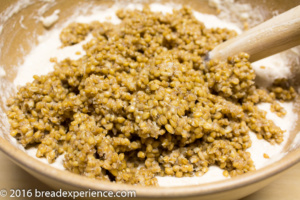
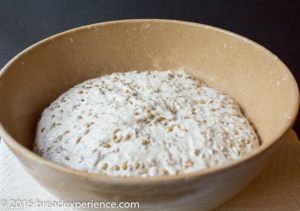
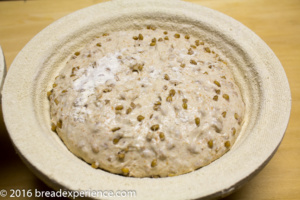
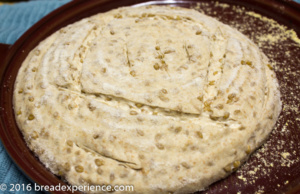
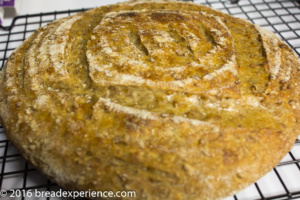
Misha Barton says
wow, very detailed article. Thanks for sharing and for your hard work.I’ll try
this recipe and let you know how sweet it is.
Cathy says
Hi Misha, do let me know how it goes.
Bethany says
Does fermenting add substantially to the flavor? I’m wondering about this step, because the baking process will kill off the microbes and probiotics gained from fermenting the grains.
Cathy says
Hi Bethany,
According to Chad Robertson, of Tartine, this method, of using porridge in breads, is a great way to incorporate more whole grains, add more depth of flavor while maintaining the structure and volume, and extend the shelf life of the bread.
I love breads made with sprouted grains and this bread takes it a step further.